Financial Analysis of Nike: Accounting Perspective
VerifiedAdded on 2021/05/31
|8
|1650
|74
Homework Assignment
AI Summary
This assignment provides a comprehensive financial analysis of Nike's performance for the fiscal year 2017. It meticulously examines key financial aspects, including revenue, accounts receivables, bad debt, inventory, and gross profit margin. The analysis delves into the impact of accounting methods like FIFO on cost of goods sold and gross profit, and further explores balance sheet equations related to bond issuance, PPE purchases, and depreciation. The document also addresses rental agreements, intangible assets (goodwill, patents), and the effects of R&D investments and acquisitions on financial statements. It includes DuPont decomposition for calculating Return on Equity (ROE), a comparison of Nike's profit margin and ROE with a competitor, and an analysis of the company's effective tax rate. Accrued liabilities, dividends, share repurchases, marketable securities, demand creation expenses, and cash flow from operations, investment, and financing are also examined to assess the company's financial health and lifecycle stage. The analysis offers a detailed understanding of Nike's financial position and performance.
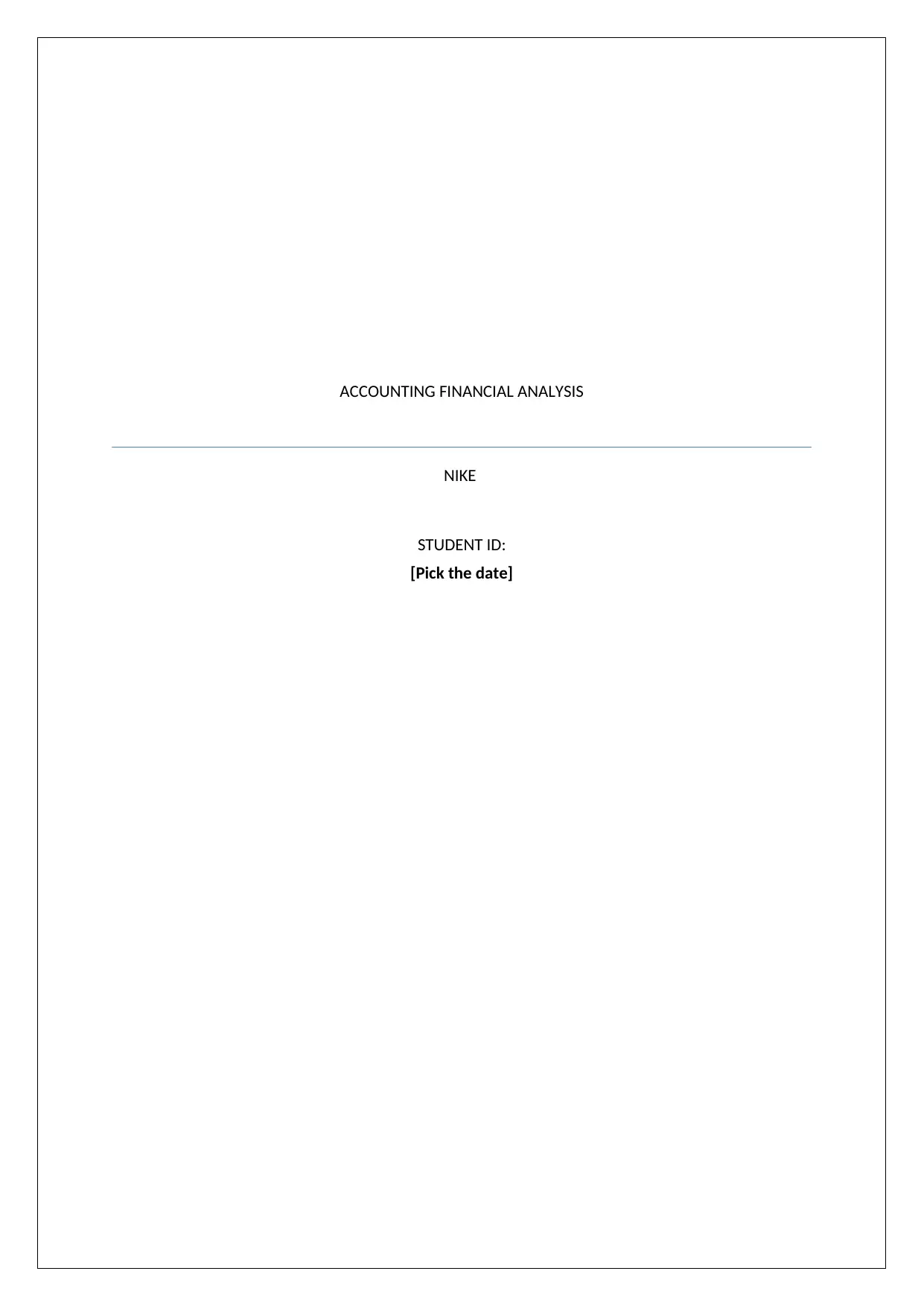
ACCOUNTING FINANCIAL ANALYSIS
NIKE
STUDENT ID:
[Pick the date]
NIKE
STUDENT ID:
[Pick the date]
Paraphrase This Document
Need a fresh take? Get an instant paraphrase of this document with our AI Paraphraser
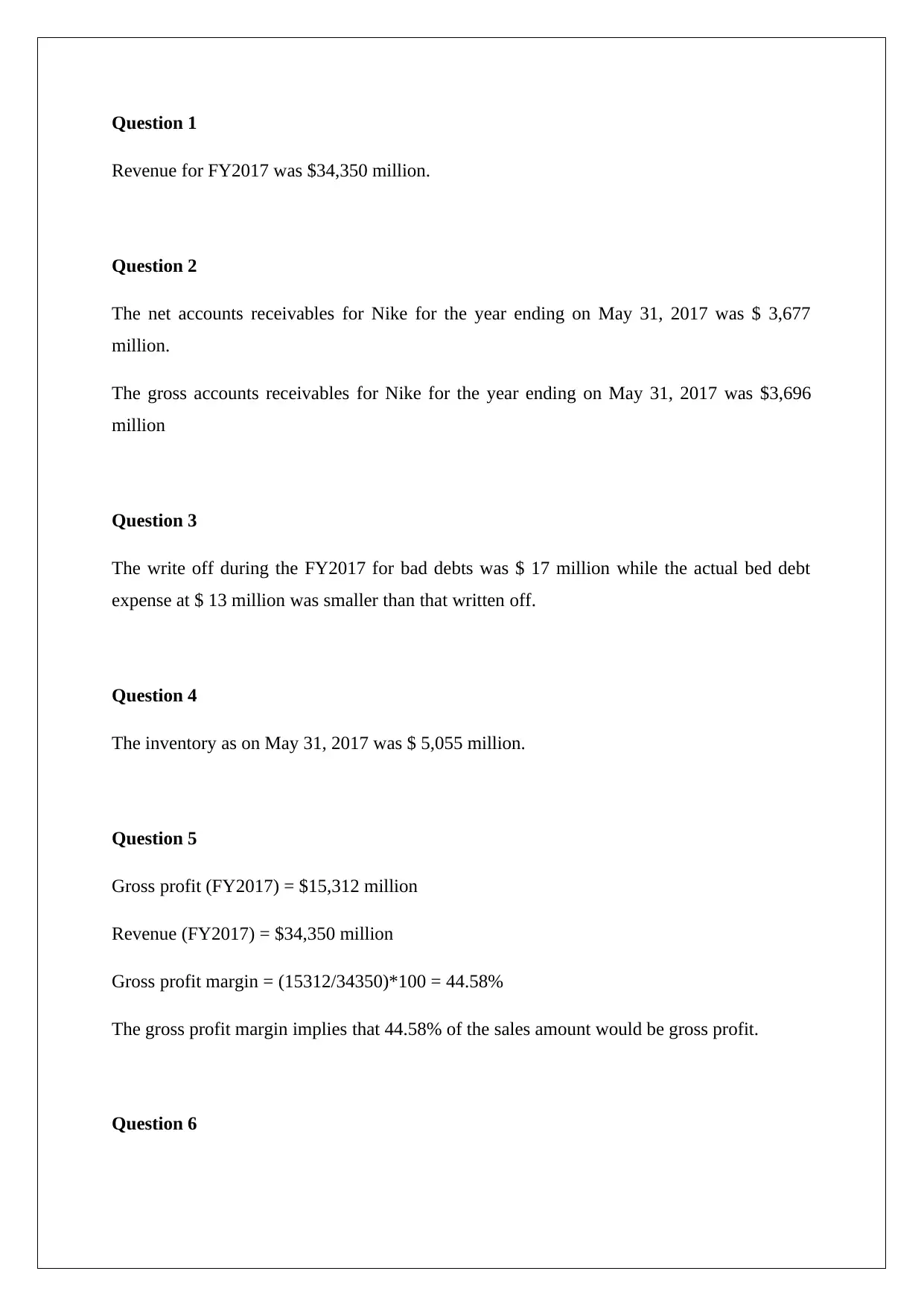
Question 1
Revenue for FY2017 was $34,350 million.
Question 2
The net accounts receivables for Nike for the year ending on May 31, 2017 was $ 3,677
million.
The gross accounts receivables for Nike for the year ending on May 31, 2017 was $3,696
million
Question 3
The write off during the FY2017 for bad debts was $ 17 million while the actual bed debt
expense at $ 13 million was smaller than that written off.
Question 4
The inventory as on May 31, 2017 was $ 5,055 million.
Question 5
Gross profit (FY2017) = $15,312 million
Revenue (FY2017) = $34,350 million
Gross profit margin = (15312/34350)*100 = 44.58%
The gross profit margin implies that 44.58% of the sales amount would be gross profit.
Question 6
Revenue for FY2017 was $34,350 million.
Question 2
The net accounts receivables for Nike for the year ending on May 31, 2017 was $ 3,677
million.
The gross accounts receivables for Nike for the year ending on May 31, 2017 was $3,696
million
Question 3
The write off during the FY2017 for bad debts was $ 17 million while the actual bed debt
expense at $ 13 million was smaller than that written off.
Question 4
The inventory as on May 31, 2017 was $ 5,055 million.
Question 5
Gross profit (FY2017) = $15,312 million
Revenue (FY2017) = $34,350 million
Gross profit margin = (15312/34350)*100 = 44.58%
The gross profit margin implies that 44.58% of the sales amount would be gross profit.
Question 6
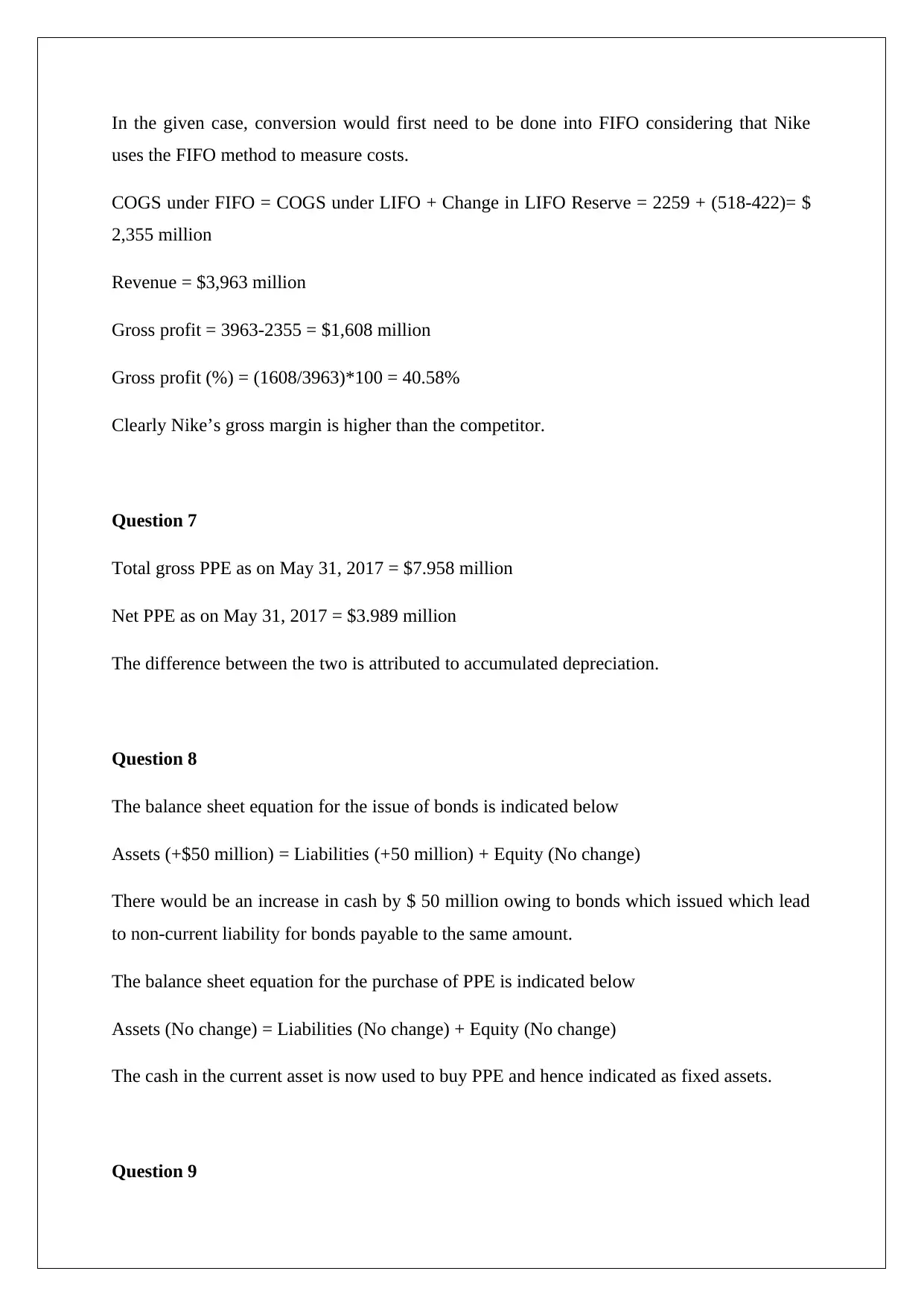
In the given case, conversion would first need to be done into FIFO considering that Nike
uses the FIFO method to measure costs.
COGS under FIFO = COGS under LIFO + Change in LIFO Reserve = 2259 + (518-422)= $
2,355 million
Revenue = $3,963 million
Gross profit = 3963-2355 = $1,608 million
Gross profit (%) = (1608/3963)*100 = 40.58%
Clearly Nike’s gross margin is higher than the competitor.
Question 7
Total gross PPE as on May 31, 2017 = $7.958 million
Net PPE as on May 31, 2017 = $3.989 million
The difference between the two is attributed to accumulated depreciation.
Question 8
The balance sheet equation for the issue of bonds is indicated below
Assets (+$50 million) = Liabilities (+50 million) + Equity (No change)
There would be an increase in cash by $ 50 million owing to bonds which issued which lead
to non-current liability for bonds payable to the same amount.
The balance sheet equation for the purchase of PPE is indicated below
Assets (No change) = Liabilities (No change) + Equity (No change)
The cash in the current asset is now used to buy PPE and hence indicated as fixed assets.
Question 9
uses the FIFO method to measure costs.
COGS under FIFO = COGS under LIFO + Change in LIFO Reserve = 2259 + (518-422)= $
2,355 million
Revenue = $3,963 million
Gross profit = 3963-2355 = $1,608 million
Gross profit (%) = (1608/3963)*100 = 40.58%
Clearly Nike’s gross margin is higher than the competitor.
Question 7
Total gross PPE as on May 31, 2017 = $7.958 million
Net PPE as on May 31, 2017 = $3.989 million
The difference between the two is attributed to accumulated depreciation.
Question 8
The balance sheet equation for the issue of bonds is indicated below
Assets (+$50 million) = Liabilities (+50 million) + Equity (No change)
There would be an increase in cash by $ 50 million owing to bonds which issued which lead
to non-current liability for bonds payable to the same amount.
The balance sheet equation for the purchase of PPE is indicated below
Assets (No change) = Liabilities (No change) + Equity (No change)
The cash in the current asset is now used to buy PPE and hence indicated as fixed assets.
Question 9
⊘ This is a preview!⊘
Do you want full access?
Subscribe today to unlock all pages.

Trusted by 1+ million students worldwide
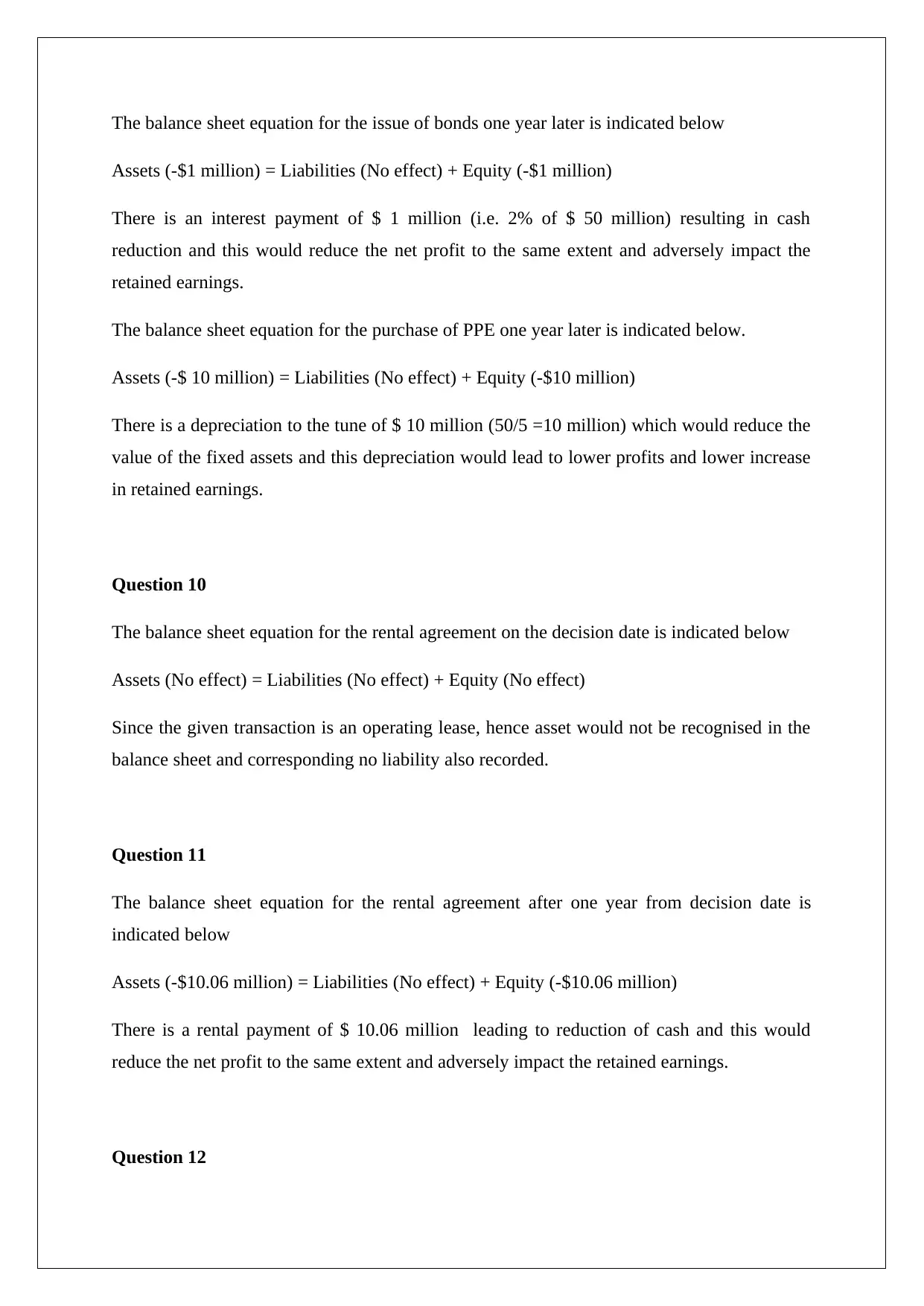
The balance sheet equation for the issue of bonds one year later is indicated below
Assets (-$1 million) = Liabilities (No effect) + Equity (-$1 million)
There is an interest payment of $ 1 million (i.e. 2% of $ 50 million) resulting in cash
reduction and this would reduce the net profit to the same extent and adversely impact the
retained earnings.
The balance sheet equation for the purchase of PPE one year later is indicated below.
Assets (-$ 10 million) = Liabilities (No effect) + Equity (-$10 million)
There is a depreciation to the tune of $ 10 million (50/5 =10 million) which would reduce the
value of the fixed assets and this depreciation would lead to lower profits and lower increase
in retained earnings.
Question 10
The balance sheet equation for the rental agreement on the decision date is indicated below
Assets (No effect) = Liabilities (No effect) + Equity (No effect)
Since the given transaction is an operating lease, hence asset would not be recognised in the
balance sheet and corresponding no liability also recorded.
Question 11
The balance sheet equation for the rental agreement after one year from decision date is
indicated below
Assets (-$10.06 million) = Liabilities (No effect) + Equity (-$10.06 million)
There is a rental payment of $ 10.06 million leading to reduction of cash and this would
reduce the net profit to the same extent and adversely impact the retained earnings.
Question 12
Assets (-$1 million) = Liabilities (No effect) + Equity (-$1 million)
There is an interest payment of $ 1 million (i.e. 2% of $ 50 million) resulting in cash
reduction and this would reduce the net profit to the same extent and adversely impact the
retained earnings.
The balance sheet equation for the purchase of PPE one year later is indicated below.
Assets (-$ 10 million) = Liabilities (No effect) + Equity (-$10 million)
There is a depreciation to the tune of $ 10 million (50/5 =10 million) which would reduce the
value of the fixed assets and this depreciation would lead to lower profits and lower increase
in retained earnings.
Question 10
The balance sheet equation for the rental agreement on the decision date is indicated below
Assets (No effect) = Liabilities (No effect) + Equity (No effect)
Since the given transaction is an operating lease, hence asset would not be recognised in the
balance sheet and corresponding no liability also recorded.
Question 11
The balance sheet equation for the rental agreement after one year from decision date is
indicated below
Assets (-$10.06 million) = Liabilities (No effect) + Equity (-$10.06 million)
There is a rental payment of $ 10.06 million leading to reduction of cash and this would
reduce the net profit to the same extent and adversely impact the retained earnings.
Question 12
Paraphrase This Document
Need a fresh take? Get an instant paraphrase of this document with our AI Paraphraser
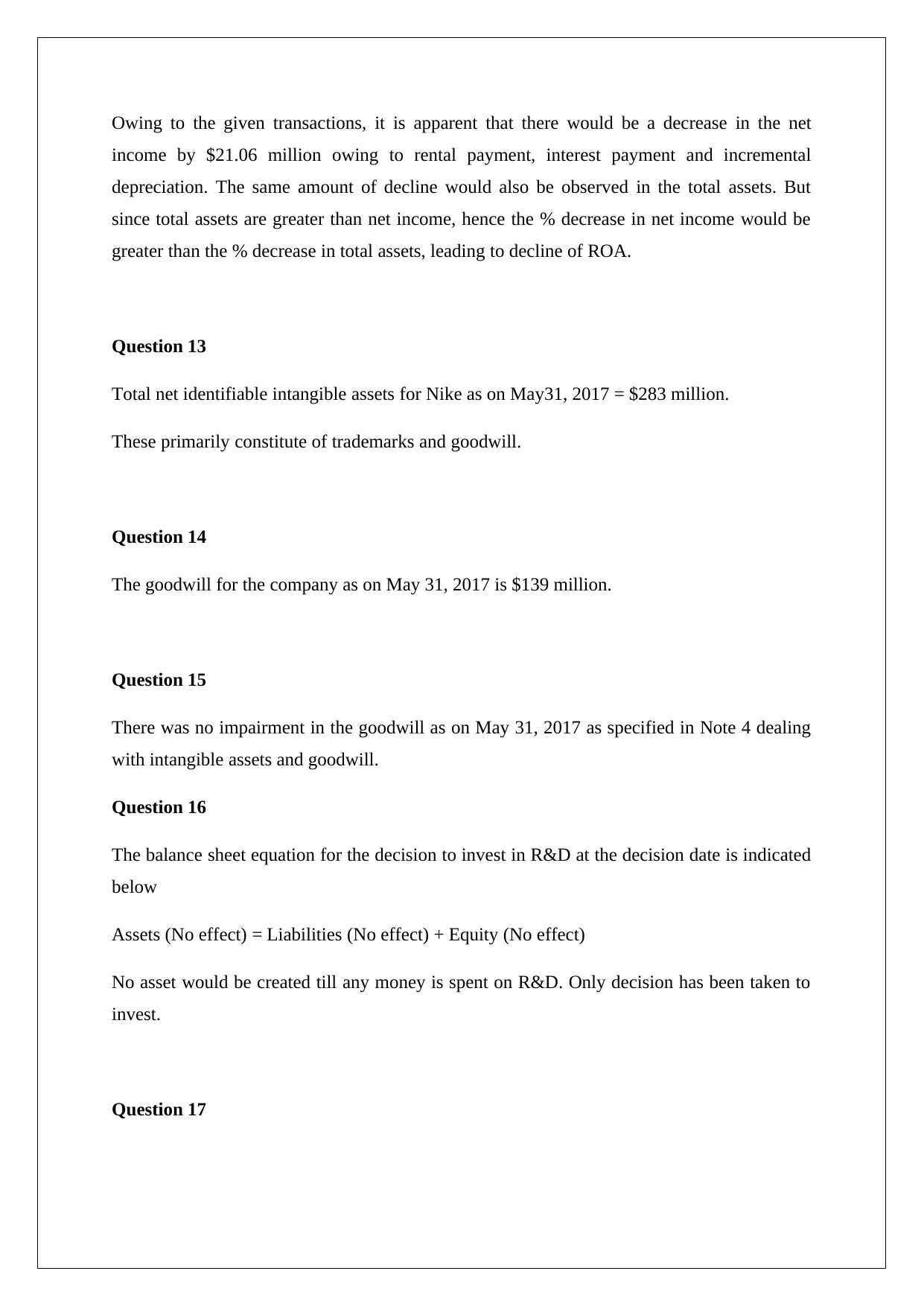
Owing to the given transactions, it is apparent that there would be a decrease in the net
income by $21.06 million owing to rental payment, interest payment and incremental
depreciation. The same amount of decline would also be observed in the total assets. But
since total assets are greater than net income, hence the % decrease in net income would be
greater than the % decrease in total assets, leading to decline of ROA.
Question 13
Total net identifiable intangible assets for Nike as on May31, 2017 = $283 million.
These primarily constitute of trademarks and goodwill.
Question 14
The goodwill for the company as on May 31, 2017 is $139 million.
Question 15
There was no impairment in the goodwill as on May 31, 2017 as specified in Note 4 dealing
with intangible assets and goodwill.
Question 16
The balance sheet equation for the decision to invest in R&D at the decision date is indicated
below
Assets (No effect) = Liabilities (No effect) + Equity (No effect)
No asset would be created till any money is spent on R&D. Only decision has been taken to
invest.
Question 17
income by $21.06 million owing to rental payment, interest payment and incremental
depreciation. The same amount of decline would also be observed in the total assets. But
since total assets are greater than net income, hence the % decrease in net income would be
greater than the % decrease in total assets, leading to decline of ROA.
Question 13
Total net identifiable intangible assets for Nike as on May31, 2017 = $283 million.
These primarily constitute of trademarks and goodwill.
Question 14
The goodwill for the company as on May 31, 2017 is $139 million.
Question 15
There was no impairment in the goodwill as on May 31, 2017 as specified in Note 4 dealing
with intangible assets and goodwill.
Question 16
The balance sheet equation for the decision to invest in R&D at the decision date is indicated
below
Assets (No effect) = Liabilities (No effect) + Equity (No effect)
No asset would be created till any money is spent on R&D. Only decision has been taken to
invest.
Question 17
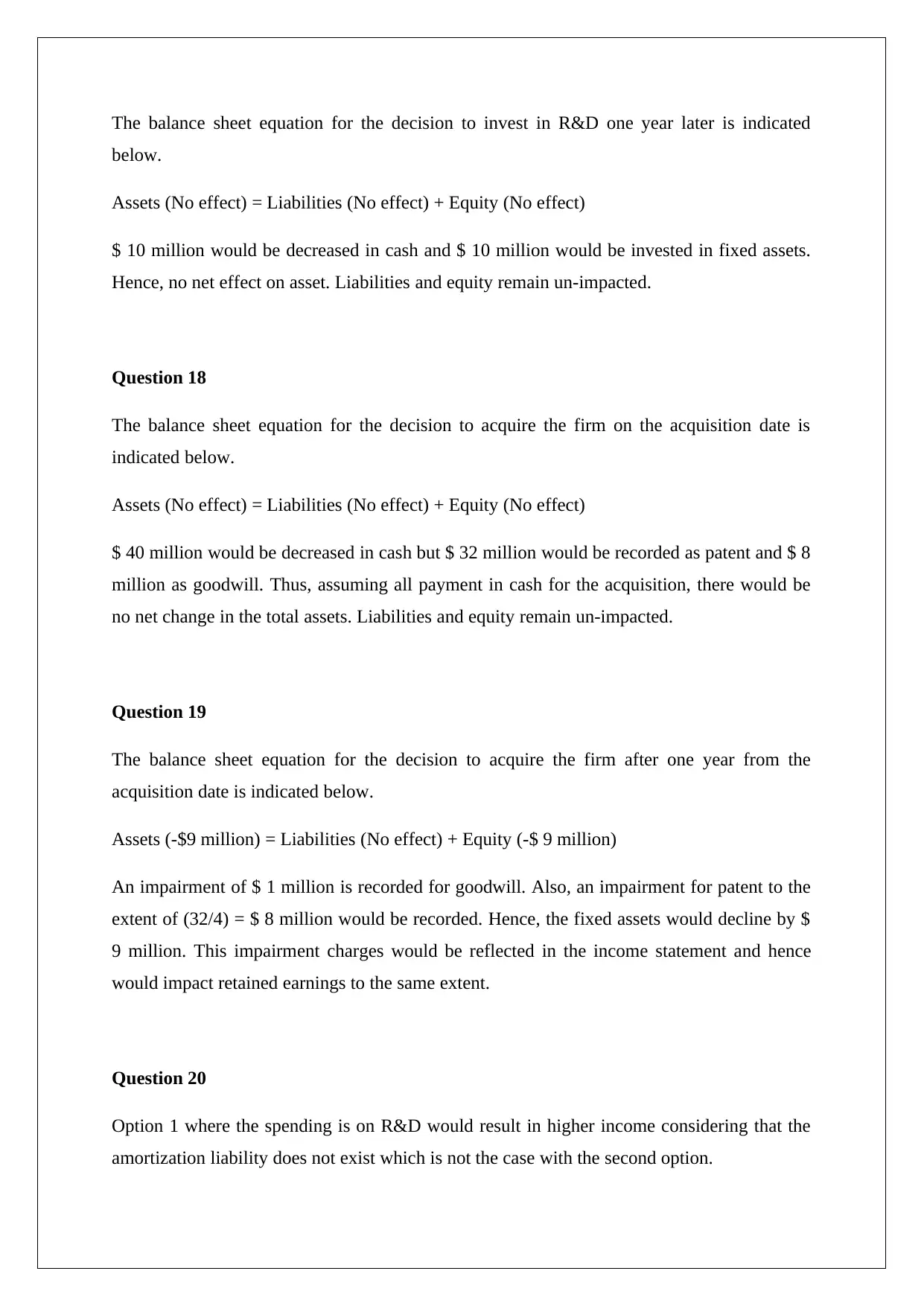
The balance sheet equation for the decision to invest in R&D one year later is indicated
below.
Assets (No effect) = Liabilities (No effect) + Equity (No effect)
$ 10 million would be decreased in cash and $ 10 million would be invested in fixed assets.
Hence, no net effect on asset. Liabilities and equity remain un-impacted.
Question 18
The balance sheet equation for the decision to acquire the firm on the acquisition date is
indicated below.
Assets (No effect) = Liabilities (No effect) + Equity (No effect)
$ 40 million would be decreased in cash but $ 32 million would be recorded as patent and $ 8
million as goodwill. Thus, assuming all payment in cash for the acquisition, there would be
no net change in the total assets. Liabilities and equity remain un-impacted.
Question 19
The balance sheet equation for the decision to acquire the firm after one year from the
acquisition date is indicated below.
Assets (-$9 million) = Liabilities (No effect) + Equity (-$ 9 million)
An impairment of $ 1 million is recorded for goodwill. Also, an impairment for patent to the
extent of (32/4) = $ 8 million would be recorded. Hence, the fixed assets would decline by $
9 million. This impairment charges would be reflected in the income statement and hence
would impact retained earnings to the same extent.
Question 20
Option 1 where the spending is on R&D would result in higher income considering that the
amortization liability does not exist which is not the case with the second option.
below.
Assets (No effect) = Liabilities (No effect) + Equity (No effect)
$ 10 million would be decreased in cash and $ 10 million would be invested in fixed assets.
Hence, no net effect on asset. Liabilities and equity remain un-impacted.
Question 18
The balance sheet equation for the decision to acquire the firm on the acquisition date is
indicated below.
Assets (No effect) = Liabilities (No effect) + Equity (No effect)
$ 40 million would be decreased in cash but $ 32 million would be recorded as patent and $ 8
million as goodwill. Thus, assuming all payment in cash for the acquisition, there would be
no net change in the total assets. Liabilities and equity remain un-impacted.
Question 19
The balance sheet equation for the decision to acquire the firm after one year from the
acquisition date is indicated below.
Assets (-$9 million) = Liabilities (No effect) + Equity (-$ 9 million)
An impairment of $ 1 million is recorded for goodwill. Also, an impairment for patent to the
extent of (32/4) = $ 8 million would be recorded. Hence, the fixed assets would decline by $
9 million. This impairment charges would be reflected in the income statement and hence
would impact retained earnings to the same extent.
Question 20
Option 1 where the spending is on R&D would result in higher income considering that the
amortization liability does not exist which is not the case with the second option.
⊘ This is a preview!⊘
Do you want full access?
Subscribe today to unlock all pages.

Trusted by 1+ million students worldwide
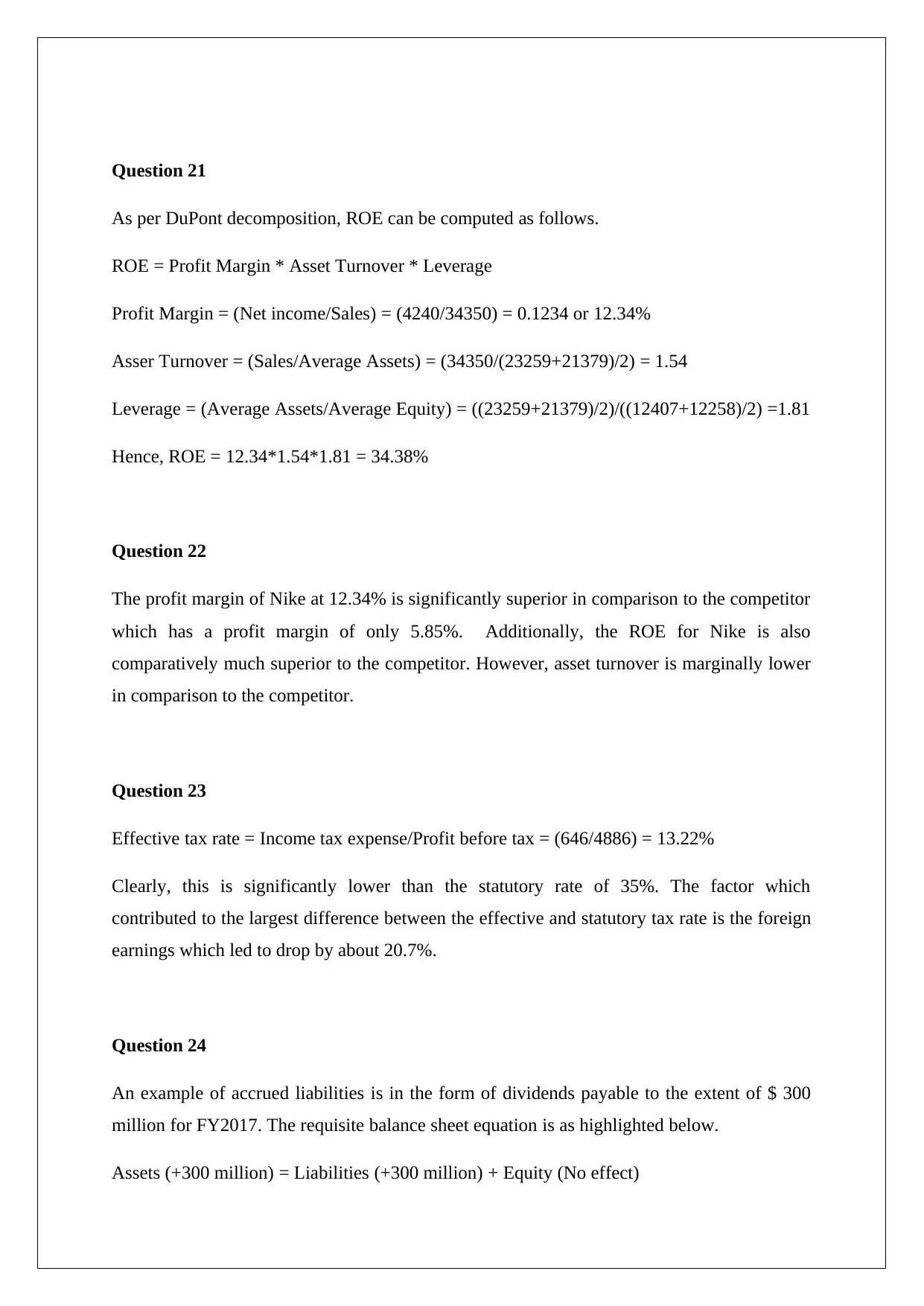
Question 21
As per DuPont decomposition, ROE can be computed as follows.
ROE = Profit Margin * Asset Turnover * Leverage
Profit Margin = (Net income/Sales) = (4240/34350) = 0.1234 or 12.34%
Asser Turnover = (Sales/Average Assets) = (34350/(23259+21379)/2) = 1.54
Leverage = (Average Assets/Average Equity) = ((23259+21379)/2)/((12407+12258)/2) =1.81
Hence, ROE = 12.34*1.54*1.81 = 34.38%
Question 22
The profit margin of Nike at 12.34% is significantly superior in comparison to the competitor
which has a profit margin of only 5.85%. Additionally, the ROE for Nike is also
comparatively much superior to the competitor. However, asset turnover is marginally lower
in comparison to the competitor.
Question 23
Effective tax rate = Income tax expense/Profit before tax = (646/4886) = 13.22%
Clearly, this is significantly lower than the statutory rate of 35%. The factor which
contributed to the largest difference between the effective and statutory tax rate is the foreign
earnings which led to drop by about 20.7%.
Question 24
An example of accrued liabilities is in the form of dividends payable to the extent of $ 300
million for FY2017. The requisite balance sheet equation is as highlighted below.
Assets (+300 million) = Liabilities (+300 million) + Equity (No effect)
As per DuPont decomposition, ROE can be computed as follows.
ROE = Profit Margin * Asset Turnover * Leverage
Profit Margin = (Net income/Sales) = (4240/34350) = 0.1234 or 12.34%
Asser Turnover = (Sales/Average Assets) = (34350/(23259+21379)/2) = 1.54
Leverage = (Average Assets/Average Equity) = ((23259+21379)/2)/((12407+12258)/2) =1.81
Hence, ROE = 12.34*1.54*1.81 = 34.38%
Question 22
The profit margin of Nike at 12.34% is significantly superior in comparison to the competitor
which has a profit margin of only 5.85%. Additionally, the ROE for Nike is also
comparatively much superior to the competitor. However, asset turnover is marginally lower
in comparison to the competitor.
Question 23
Effective tax rate = Income tax expense/Profit before tax = (646/4886) = 13.22%
Clearly, this is significantly lower than the statutory rate of 35%. The factor which
contributed to the largest difference between the effective and statutory tax rate is the foreign
earnings which led to drop by about 20.7%.
Question 24
An example of accrued liabilities is in the form of dividends payable to the extent of $ 300
million for FY2017. The requisite balance sheet equation is as highlighted below.
Assets (+300 million) = Liabilities (+300 million) + Equity (No effect)
Paraphrase This Document
Need a fresh take? Get an instant paraphrase of this document with our AI Paraphraser
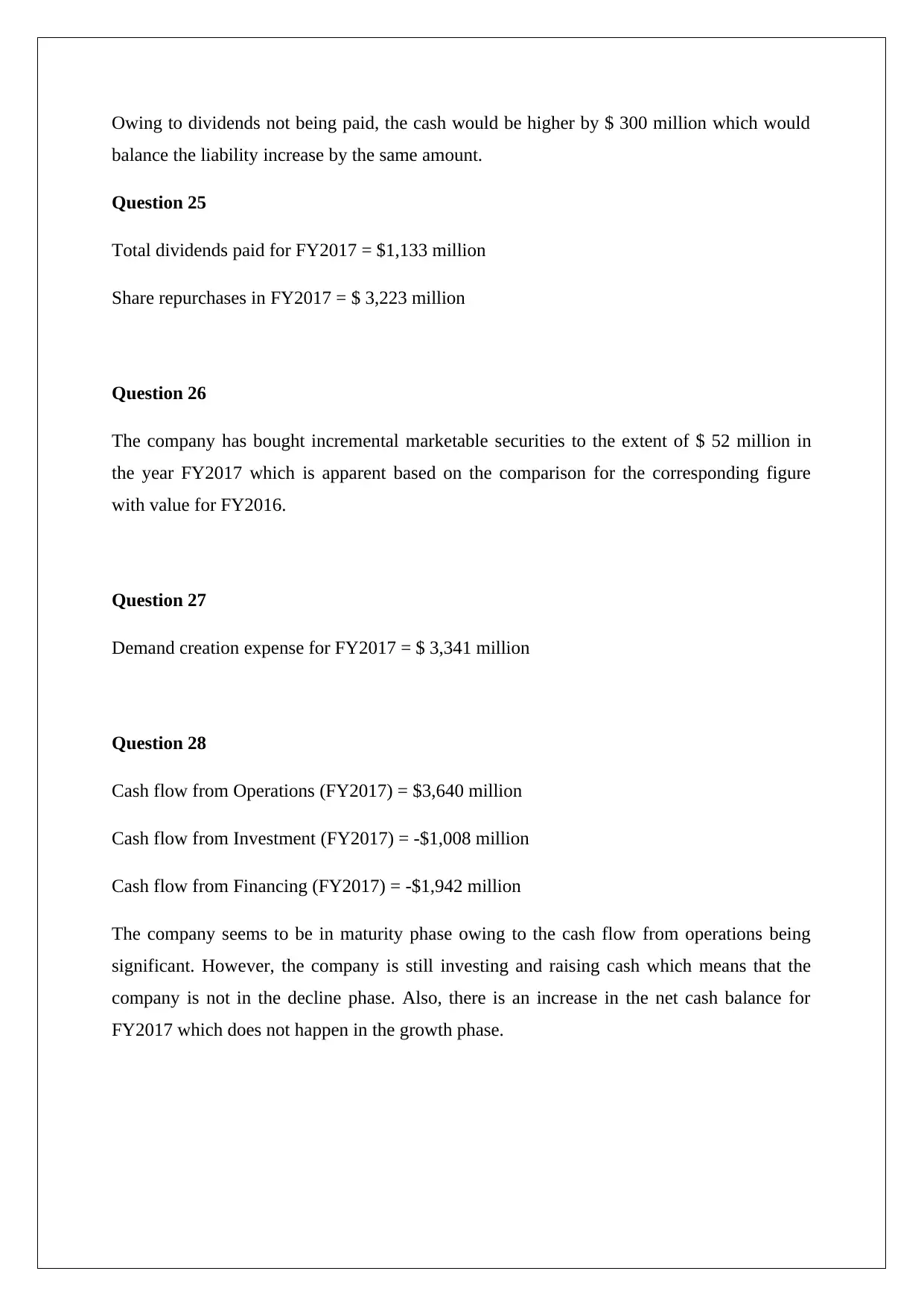
Owing to dividends not being paid, the cash would be higher by $ 300 million which would
balance the liability increase by the same amount.
Question 25
Total dividends paid for FY2017 = $1,133 million
Share repurchases in FY2017 = $ 3,223 million
Question 26
The company has bought incremental marketable securities to the extent of $ 52 million in
the year FY2017 which is apparent based on the comparison for the corresponding figure
with value for FY2016.
Question 27
Demand creation expense for FY2017 = $ 3,341 million
Question 28
Cash flow from Operations (FY2017) = $3,640 million
Cash flow from Investment (FY2017) = -$1,008 million
Cash flow from Financing (FY2017) = -$1,942 million
The company seems to be in maturity phase owing to the cash flow from operations being
significant. However, the company is still investing and raising cash which means that the
company is not in the decline phase. Also, there is an increase in the net cash balance for
FY2017 which does not happen in the growth phase.
balance the liability increase by the same amount.
Question 25
Total dividends paid for FY2017 = $1,133 million
Share repurchases in FY2017 = $ 3,223 million
Question 26
The company has bought incremental marketable securities to the extent of $ 52 million in
the year FY2017 which is apparent based on the comparison for the corresponding figure
with value for FY2016.
Question 27
Demand creation expense for FY2017 = $ 3,341 million
Question 28
Cash flow from Operations (FY2017) = $3,640 million
Cash flow from Investment (FY2017) = -$1,008 million
Cash flow from Financing (FY2017) = -$1,942 million
The company seems to be in maturity phase owing to the cash flow from operations being
significant. However, the company is still investing and raising cash which means that the
company is not in the decline phase. Also, there is an increase in the net cash balance for
FY2017 which does not happen in the growth phase.
1 out of 8
Related Documents
Your All-in-One AI-Powered Toolkit for Academic Success.
+13062052269
info@desklib.com
Available 24*7 on WhatsApp / Email
![[object Object]](/_next/static/media/star-bottom.7253800d.svg)
Unlock your academic potential
Copyright © 2020–2025 A2Z Services. All Rights Reserved. Developed and managed by ZUCOL.





